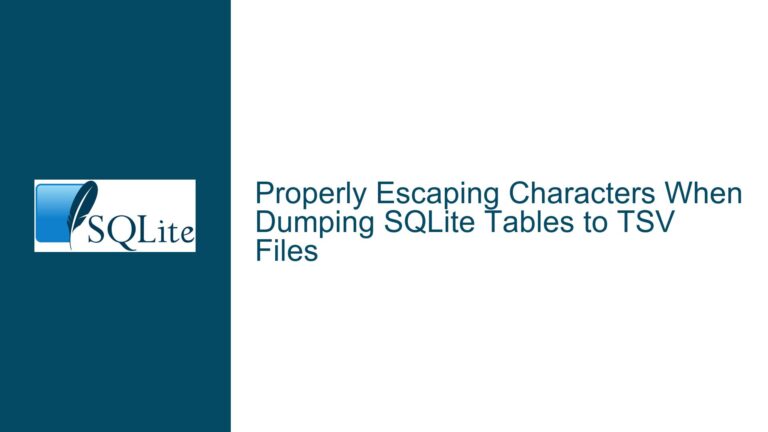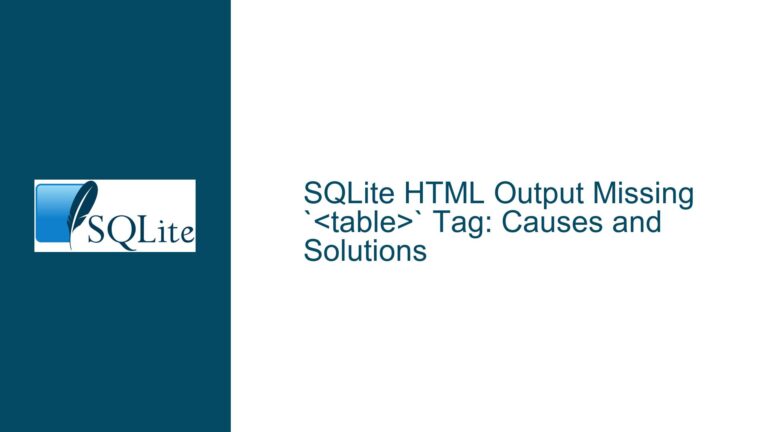SQLite Table Headers Not Displaying in Terminal: Causes and Permanent Fixes
Understanding the Absence of Headers in SQLite Terminal Output
When working with SQLite, particularly in a terminal environment, users often expect to see column headers displayed alongside the data when executing a SELECT query. However, the default behavior of the SQLite command-line interface (CLI) is to output data in a pipe-separated format without headers. This can be confusing, especially for those transitioning from graphical interfaces like the SQLite extension in VSCode, which automatically displays headers. The absence of headers in the terminal output can lead to difficulties in data interpretation, template integration, and scripting, particularly when using frameworks like Flask or templating engines like Jinja2.
The core issue lies in the configuration of the SQLite CLI. By default, the CLI does not enable headers, as it is designed to be a lightweight, scriptable tool. However, this behavior can be modified through specific commands or startup configurations. Understanding why this happens and how to address it requires a deeper dive into the SQLite CLI’s behavior, its configuration options, and the distinction between the data schema (which inherently includes column names) and the presentation layer (which determines how data is displayed).
Exploring the Causes of Missing Headers in SQLite Terminal Output
The absence of headers in SQLite terminal output stems from the default settings of the SQLite CLI. Unlike graphical interfaces, which are designed for human readability and often include headers by default, the CLI prioritizes simplicity and scriptability. This design choice ensures that the output is easily parsable by other programs or scripts, where headers might be unnecessary or even disruptive.
One of the primary causes is the lack of automatic header enabling in the CLI. When you execute a query like SELECT * FROM my_table, the CLI outputs the data in a raw, pipe-separated format. This format is ideal for piping data into other commands or scripts but is less user-friendly for direct human consumption. Additionally, the CLI does not persist configuration changes between sessions by default. This means that even if you enable headers during one session, they will not be enabled in subsequent sessions unless you explicitly configure the CLI to do so.
Another factor is the distinction between the data schema and its presentation. SQLite tables inherently include column names as part of their schema. However, these names are not automatically included in the output unless explicitly requested. This separation between schema and presentation allows for greater flexibility but can lead to confusion when users expect headers to appear by default.
Resolving the Issue: Enabling Headers and Configuring Persistent Settings
To address the issue of missing headers in SQLite terminal output, you can enable headers either temporarily for a single session or permanently by configuring the SQLite CLI. Here’s a detailed guide on how to achieve both:
Enabling Headers Temporarily
For a single session, you can enable headers by using the .headers on command within the SQLite CLI. This command instructs the CLI to include column headers in the output of subsequent queries. For example:
.headers on
SELECT * FROM my_table;
This will produce output with headers, making it easier to interpret the data. However, this setting is not persistent and will need to be re-enabled in future sessions.
Enabling Headers Permanently
To enable headers permanently, you can create a .sqliterc file in your home directory. This file contains commands that are automatically executed whenever the SQLite CLI starts. Here’s how to set it up:
Locate Your Home Directory:
- On Unix-like systems (Linux, macOS), your home directory is typically located at
/home/usernameor/Users/username. You can navigate to it using the commandcd ~. - On Windows, your home directory is usually located at
C:\Users\Username. You can navigate to it using the commandcd /d %UserProfile%.
- On Unix-like systems (Linux, macOS), your home directory is typically located at
Create the
.sqlitercFile:- In your home directory, create a new file named
.sqliterc. This file should contain the command.headers on. You can create and edit this file using a text editor likenano,vim, or Notepad.
- In your home directory, create a new file named
Verify the Configuration:
- After creating the
.sqlitercfile, start the SQLite CLI. The headers should now be enabled by default for all queries.
- After creating the
Using the -header Flag
Alternatively, you can start the SQLite CLI with the -header flag to enable headers for that session. This approach is useful if you prefer not to modify your global configuration. For example:
sqlite3 -header my_db
This command starts the SQLite CLI with headers enabled, ensuring that all queries in that session include headers in their output.
Integrating Headers with Templating Engines
If you are using a templating engine like Jinja2, the absence of headers can complicate data integration. By enabling headers as described above, you can ensure that your templates can correctly reference column names. For example, in a Flask application, you might use the following code to fetch data and pass it to a Jinja2 template:
import sqlite3
def get_car_data():
conn = sqlite3.connect('my_db')
conn.row_factory = sqlite3.Row # Ensure rows are returned as dictionaries
cursor = conn.cursor()
cursor.execute("SELECT * FROM my_table")
data = cursor.fetchall()
conn.close()
return data
In your Jinja2 template, you can then reference column names directly:
<table>
<tr>
<th>ID</th>
<th>Brand</th>
<th>Model</th>
<th>Year</th>
<th>Mileage</th>
<th>Price</th>
</tr>
{% for row in data %}
<tr>
<td>{{ row['id'] }}</td>
<td>{{ row['brand'] }}</td>
<td>{{ row['model'] }}</td>
<td>{{ row['year'] }}</td>
<td>{{ row['mileage'] }}</td>
<td>{{ row['price'] }}</td>
</tr>
{% endfor %}
</table>
By ensuring that headers are enabled in your SQLite CLI, you can streamline the process of integrating SQLite data with templating engines and other presentation layers.
Conclusion
The absence of headers in SQLite terminal output is a common issue that arises from the CLI’s default settings. By understanding the causes and implementing the appropriate solutions, you can ensure that headers are consistently displayed, improving the readability and usability of your SQLite data. Whether you choose to enable headers temporarily, configure them permanently, or integrate them with templating engines, these steps will help you achieve a more seamless and efficient workflow.






